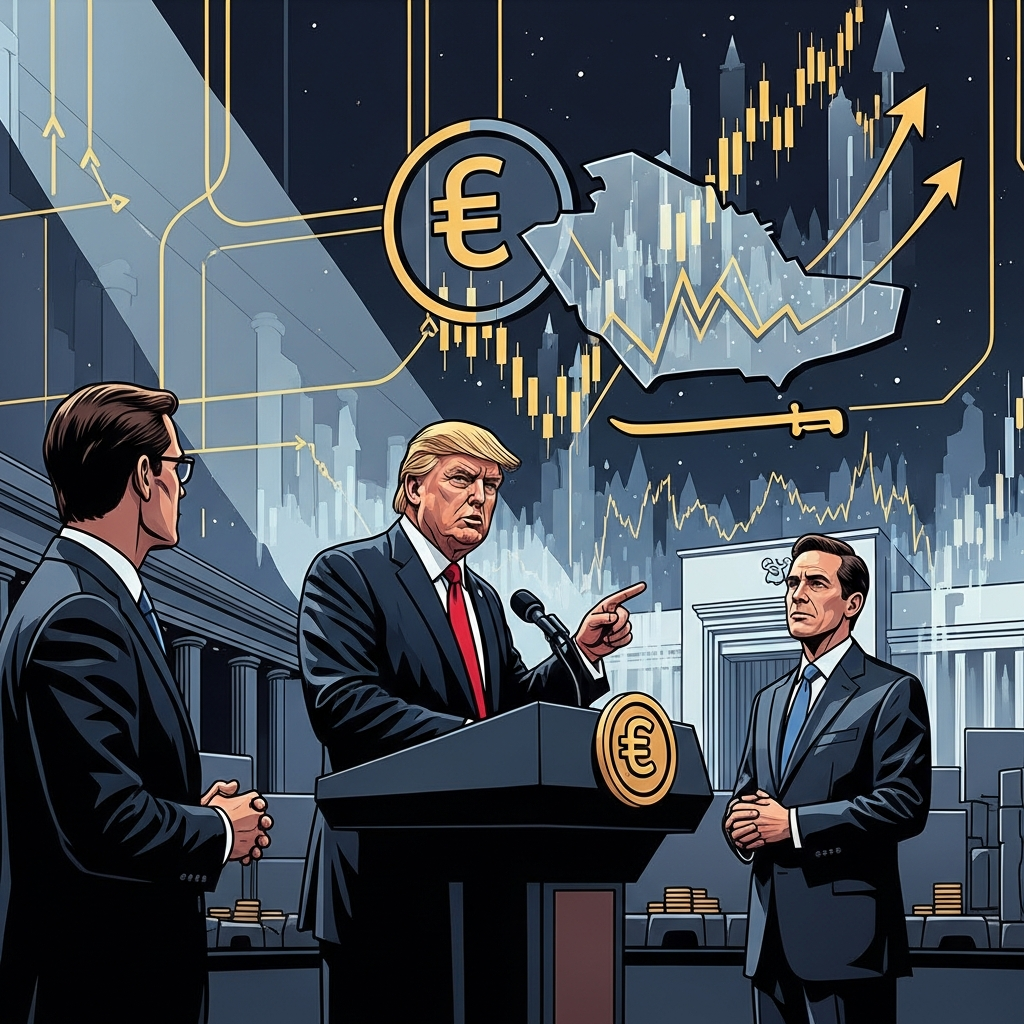President Donald Trump has ignited a fresh round of controversy with a stark warning to Treasury Secretary Scott Bessent: engineer cuts to Federal Reserve interest rates, or face dismissal. This dramatic public challenge, delivered during a US-Saudi investment forum, thrusts the crucial independence of the nation’s central bank back into the spotlight. As financial markets watch closely, the president’s demand highlights deep tensions between political pressures and the Fed’s mandate to maintain economic stability.
President’s Public Ultimatum Rocks Washington
On Wednesday, President Donald Trump publicly threatened Treasury Secretary Scott Bessent with termination if the Federal Reserve did not swiftly lower interest rates. Speaking at the Kennedy Center in Washington, DC, during a US-Saudi investment forum, Trump’s remarks were unambiguous. “The only thing Scott is blowing it on is the Fed because the Fed, the rates are too high, Scott,” the president declared, a smirk accompanying his words. “If you don’t get it fixed fast, I’m going to fire your ass.” This aggressive stance against his own Treasury Secretary, observed on November 5, 2025, underscores Trump’s consistent desire for more accommodative monetary policy, despite the Fed’s statutory independence.
The Federal Reserve’s Independent Mandate
The Federal Reserve operates as an independent entity, making monetary policy decisions based solely on comprehensive economic data. Its primary objectives, known as the “dual mandate,” are to achieve maximum sustainable employment and maintain stable prices. This critical independence is designed to insulate the central bank from short-term political pressures, allowing it to make sound, long-term economic judgments. Consequently, a presidential directive, or even the dismissal of a Treasury Secretary, does not directly compel the Fed to alter its course on interest rates.
Several Fed officials have recently voiced ongoing concerns about inflationary pressures. These worries suggest a cautious approach to further rate cuts, potentially leaning against the aggressive reductions sought by President Trump. The intricate balance between controlling inflation and fostering employment guides every decision by the powerful Federal Open Market Committee (FOMC).
Scott Bessent: A “Voice of Reason” Amidst Political Pressure
Treasury Secretary Scott Bessent has emerged as a respected figure on Wall Street. Intriguingly, reports suggest Bessent has been privately advocating against President Trump’s repeated threats to fire current Federal Reserve Chair Jerome Powell. The president himself alluded to this, appearing to describe Bessent as a “voice of reason” within his administration.
In contrast, Commerce Secretary Howard Lutnick reportedly holds a different view, favoring Powell’s removal. Trump recounted an exchange, seemingly repeating Bessent’s plea: “Please don’t fire him. He’s got three months to go.” The president then reenacted his own response, stating, “I want to get him out.” This internal debate highlights the differing perspectives on the critical role and future of the Fed Chair within Trump’s cabinet.
Wall Street’s Perspective on Bessent
Financial markets have shown considerable appreciation for Bessent’s presence. James Ragan, director of wealth management research at DA Davidson, noted to CNN that Bessent “has been very much the voice of reason in the Trump administration.” Ragan added, “I don’t like to hear him challenging Bessent.” This sentiment reflects a broader market desire for stability and predictability, qualities Bessent is perceived to bring to the administration’s economic policy discussions.
Past threats by Trump to dismiss Powell during the spring of his second term were eventually retracted. This came after close advisers warned of potential chaos in financial markets. Wednesday’s revelation marks the first time Bessent has been publicly identified as one of the key figures urging the president to retain Powell until his term concludes.
Navigating the Fed’s Rate Decisions and Presidential Influence
The Federal Reserve’s rate-setting committee, chaired by Jerome Powell, has initiated rate adjustments. After a nine-month period, the Fed began lowering interest rates in September. A subsequent quarter-point cut occurred at its latest meeting last month. These October reductions brought the benchmark lending rate to its lowest point in three years. These decisions were largely aimed at preventing a surge in unemployment.
However, a robust debate continues among Fed officials. Some argue against further rate cuts, pointing to inflation still exceeding their 2% target. They also consider the potential for President Trump’s tariffs to exacerbate inflationary pressures. The minutes from the Fed’s October meeting underscored these divisions, with many participants suggesting a preference to hold rates steady for the remainder of the year.
The Limits of Presidential Power Over the Fed
Despite the president’s vocal demands for aggressive rate cuts and his public criticism of Chair Powell, the mechanisms of the Fed mean direct presidential influence is limited. Powell’s term concludes in May. While Trump could name Powell’s successor as early as December – with Bessent reportedly leading the search for five shortlisted candidates – even a loyalist appointee would face significant constraints. The Fed Chair holds only one vote on the 12-person rate-setting committee. They cannot unilaterally veto the majority’s decision.
Any new Fed Chair, regardless of their personal stance, would need to build consensus among their colleagues for any aggressive rate-cutting strategy. Currently, only one Fed official, Governor Stephen Miran, openly advocates for such an approach. Miran is temporarily serving on the Fed’s board, taking an unpaid leave from his role as a top White House economist. The upcoming release of new September labor market data, delayed by a government shutdown, will be closely monitored. A significant downturn in the labor market could prompt the Fed to consider further borrowing cost reductions into next year, but inflation remains a critical watchpoint.
Frequently Asked Questions
How does the Federal Reserve set interest rates independently?
The Federal Reserve sets interest rates based on its dual mandate: achieving maximum sustainable employment and maintaining stable prices. It analyzes a wide range of economic data, including inflation, employment figures, and global economic conditions, rather than responding to political directives. This independence is crucial for long-term economic stability and to prevent short-term political cycles from destabilizing monetary policy. Decisions are made by the Federal Open Market Committee (FOMC) through a voting process involving multiple members.
What is Scott Bessent’s role in influencing Federal Reserve decisions?
As Treasury Secretary, Scott Bessent does not have a direct role in setting Federal Reserve interest rates. The Treasury Department and the Federal Reserve are distinct entities. Bessent’s influence primarily lies in his advisory capacity to the President on economic matters and his role in facilitating discussions on broader economic policy. The article highlights his position as a “voice of reason” within the administration, advising President Trump on the implications of actions concerning the Fed Chair, rather than directly influencing monetary policy.
What are the potential consequences if a President attempts to interfere with Federal Reserve policy?
Direct presidential interference with Federal Reserve policy carries significant risks. It can undermine the central bank’s credibility and perceived independence, leading to instability and uncertainty in financial markets. Investors might lose confidence, potentially causing market volatility, higher borrowing costs, and a weaker currency. Such actions could also politicize monetary policy, making it less effective in achieving its core mandates of stable prices and maximum employment, ultimately harming the broader economy.
Conclusion
President Trump’s public threat to Treasury Secretary Scott Bessent over Federal Reserve interest rates marks a significant moment in the ongoing tension between political will and central bank independence. While the president’s frustration with high rates is clear, the Fed’s decisions are rooted in economic data and its dual mandate to foster employment and price stability, not political pressure. Bessent, lauded by Wall Street as a “voice of reason,” has seemingly played a crucial, albeit private, role in moderating some of the president’s more aggressive instincts regarding the Fed Chair. As the debate over interest rates continues, the steadfast independence of the Federal Reserve remains a cornerstone of the nation’s economic framework, navigating complex pressures to ensure stability for all.




